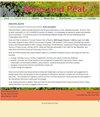利用航空图像和波形记录激光雷达对北方沼泽的微观形态进行精细分辨率测绘
IF 1.5
4区 环境科学与生态学
Q4 ENVIRONMENTAL SCIENCES
引用次数: 8
摘要
北方沼泽是大气碳的重要储存库和汇,其表面以植被微形态为特征。由于植被组成的变化导致其功能的改变,例如与大气的碳气体交换,因此需要有效的监测方法。我们研究了机载图像和波形记录激光雷达数据如何用于开放沼泽中微观形态的3D测绘,该沼泽是由水池、带有一些矮小松树的小丘、洼地、中间表面和泥底洼地组成的马赛克。该方法适用于利用激光雷达重建的沼泽表面。植被分类分辨率为20 cm。我们假设LiDAR数据描述地表地形、湿度、野外层植被的存在和深度以及地表粗糙度;而多幅图像捕捉植被的颜色和纹理,这是受定向反射效应的影响。我们得出结论,几何激光雷达特征是微形态的有效预测因子。激光雷达强度和回波宽度分别与湿度和表面粗糙度有关。定向反射占图像方差的4 - 34%,其形式与现场层的存在有关。微形态的定向反射模式被认为在增强分类方面具有边缘价值,RGB图像特征不如LiDAR变量。传感器融合是对这些栖息地进行精细测绘的一个有吸引力的选择。我们讨论了这项任务,并提出了改进方法的选择。本文章由计算机程序翻译,如有差异,请以英文原文为准。
Fine-resolution mapping of microforms of a boreal bog using aerial images and waveform-recording LiDAR
Boreal bogs are important stores and sinks of atmospheric carbon whose surfaces are characterised by vegetation microforms. Efficient methods for monitoring their vegetation are needed because changes in vegetation composition lead to alteration in their function such as carbon gas exchange with the atmosphere. We investigated how airborne image and waveform-recording LiDAR data can be used for 3D mapping of microforms in an open bog which is a mosaic of pools, hummocks with a few stunted pines, hollows, intermediate surfaces and mud-bottom hollows. The proposed method operates on the bog surface, which is reconstructed using LiDAR. The vegetation was classified at 20 cm resolution. We hypothesised that LiDAR data describe surface topography, moisture and the presence and depth of field-layer vegetation and surface roughness; while multiple images capture the colours and texture of the vegetation, which are influenced by directional reflectance effects. We conclude that geometric LiDAR features are efficient predictors of microforms. LiDAR intensity and echo width were specific to moisture and surface roughness, respectively. Directional reflectance constituted 4–34 % of the variance in images and its form was linked to the presence of the field layer. Microform-specific directional reflectance patterns were deemed to be of marginal value in enhancing the classification, and RGB image features were inferior to LiDAR variables. Sensor fusion is an attractive option for fine-scale mapping of these habitats. We discuss the task and propose options for improving the methodology.
求助全文
通过发布文献求助,成功后即可免费获取论文全文。
去求助
来源期刊

Mires and Peat
ENVIRONMENTAL SCIENCES-
CiteScore
2.30
自引率
16.70%
发文量
0
审稿时长
33 weeks
期刊介绍:
Mires and Peat is a peer-reviewed internet journal focusing specifically on mires, peatlands and peat. As a truly “free-to-users” publication (i.e. NO CHARGES to authors OR readers), it is immediately accessible to readers and potential authors worldwide. It is published jointly by the International Peatland Society (IPS) and the International Mire Conservation Group (IMCG).
Mires and Peat is indexed by Thomson Reuters Web of Science (2017 Impact Factors: 1.326 [two-year] and 1.638 [five-year]), Elsevier Scopus, EBSCO Environment Complete, CABI Abstracts, CSA Proquest (including their Aquatic Science and Fisheries Abstracts ASFA, Ecology, Entomology, Animal Behavior, Aqualine and Pollution databases) and Directory of Open Access Journals (DOAJ). Mires and Peat also participates in the CABI Full Text Repository, and subscribes to the Portico E-journal Preservation Service (LTPA).
Mires and Peat publishes high-quality research papers on all aspects of peatland science, technology and wise use, including:
ecology, hydrology, survey, inventory, classification, functions and values of mires and peatlands;
scientific, economic and human aspects of the management of peatlands for agriculture, forestry, nature conservation, environmental protection, peat extraction, industrial development and other purposes;
biological, physical and chemical characteristics of peat; and
climate change and peatlands.
Short communications and review articles on these and related topics will also be considered; and suggestions for special issues of the Journal based on the proceedings of conferences, seminars, symposia and workshops will be welcomed. The submission of material by authors and from countries whose work would otherwise be inaccessible to the international community is particularly encouraged.
 求助内容:
求助内容: 应助结果提醒方式:
应助结果提醒方式:


